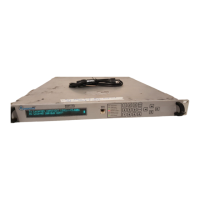AMT-70/AMT-73/AMT-75 Installation and Operation
The AMT-70 modem supports a fast binary protocol through the back-panel RS-485 interface used to
control the modem from a client application running on a master workstation.
The client station can be based on Windows or Linux. The modem acts as a server application and
executes the configuration/monitoring query from this station.
The client application can control the following components on the AMT-73L modem:
The modulator
The demodulator
The data interface card
The BUC/LNB units (not required for AMT-73L)
7.3 The Packet Protocol
The packet protocol allows a client application (typically running on a master PC) to control multiple
clients modems using a binary exchange protocol.
The master unit send the requests on a multi-drop RS-485 cable
7
to the slave modems The master
modem always controls the transmit channel (TX) and the slave modems exchange the control of the
(RX) channel on the bus.
In a typical configuration, the master modem sends 10 bytes binary requests to one of several (slave)
modems on a network. These requests can gather information (GET request) or configure the slave
modems (SET requests). The tributary modems are referenced by a specific address. This address is
defined by the MCADD command. A maximum of 13 modems can be controlled by one master station.
When one of the tributary modems recognizes his address in the frame header, the request is
processed and it takes control of the RS-485 bus (RX side) for sending the response. The bus is after
frees up.
The master continues to poll alternatively (in round-robin mode) all slaves on the bus.
This packet mode is supported when customer specific applications are required. This mode is a
complement to the CLI (Serial / Telnet) and SNMP modes.
The detailed packet protocol specifications are documented in the reference manual;
AMT-70 Series; Packet Protocol Specification, AdvantechAMT 2005
These specifications describe in detail the protocol handshaking and the request/response binary
frame structure.
This document is available upon request from your customer support.
105
7
The RS485 pinout for the AMT70/73L modems is described at page 112.

